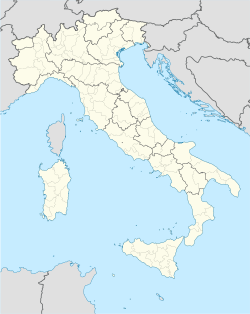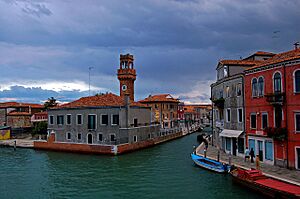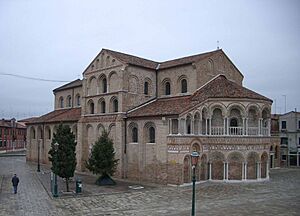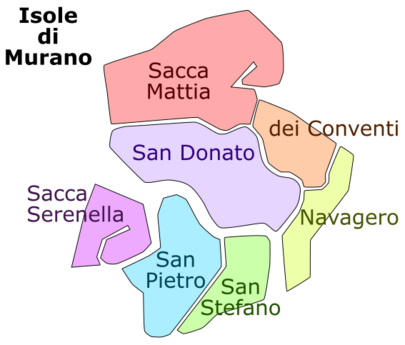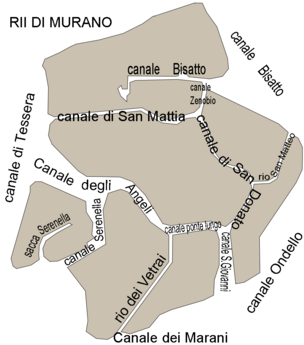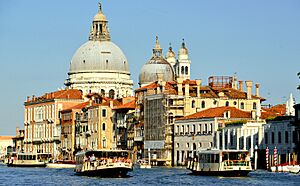Murano facts for kids

Rio dei Vetrai, Murano (2015)
|
|
| Geography | |
|---|---|
| Coordinates | 45°27′27″N 12°21′13″E / 45.45750°N 12.35361°E |
| Adjacent bodies of water | Venetian Lagoon |
| Administration | |
| Region | Veneto |
| Province | Province of Venice |
Murano is a group of islands connected by bridges, located in the Venetian Lagoon in northern Italy. It's about 1.5 kilometers (about 1 mile) north of Venice. The whole area measures about 1.5 kilometers (about 1 mile) across and had a population of just over 5,000 people in 2004. Murano is super famous for its amazing glass making. It used to be its own independent town (called a comune), but now it's a part of the larger city of Venice (known as a frazione).
Contents
A Look Back: Murano's History
Murano was first settled by the Romans, and then by people from nearby towns like Altinum and Oderzo starting in the 500s. In its early days, the island grew as a busy fishing port and a place where salt was made. It was also an important trading hub, controlling a port on the island of Sant'Erasmo.
However, from the 1000s, fewer people lived there as many moved to Dorsoduro, a part of Venice. Murano even had its own "Grand Council," similar to Venice's government. But by the 1200s, Murano was mostly governed by an official from Venice called a podestà. What's cool is that unlike other islands in the Venetian Lagoon, Murano actually made its own coins!
The Monastery of St. Michael
Early in the 1000s, a group of religious people called hermits came to one of Murano's islands. They were looking for a quiet place to live their simple, spiritual lives. There, they started the Monastery of St. Michael (in Italian, S. Michele di Murano).
This monastery became a very important center for learning and printing books. A famous cartographer (mapmaker) named Fra Mauro, whose maps were super important for European explorers discovering the world, was a monk in this community. Sadly, the monastery was closed down in 1810 by French forces led by Napoleon when they took over Italy. The monks were forced to leave in 1814. After that, the monastery grounds became Venice's main cemetery.
Why Glassmakers Moved to Murano
In 1291, something big happened: all the glassmakers in Venice were ordered to move their workshops to Murano. This was because the city of Venice was mostly built of wood, and the hot glass furnaces were a huge fire risk!
In the next century, Murano's glass became famous worldwide, and they started exporting it. The island became known first for beautiful glass beads and mirrors. A special type of glass called Aventurine glass was even invented there! For a while, Murano was the most important place for glass production in all of Europe. Later, the island also became famous for its amazing chandeliers. Even though things slowed down a bit in the 1700s, glassmaking is still the main industry on Murano today.
Murano as a Resort Island
In the 1400s, Murano became a popular resort spot for wealthy Venetians, who built fancy palaces there. However, this trend later faded. The countryside of the island used to be full of orchards and vegetable gardens until the 1800s, when more houses were built.
The Art of Murano Glassmaking
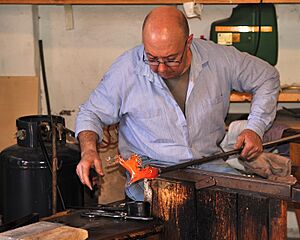
Murano's fame for glassmaking really took off when the Venetian Republic (the government of Venice) made all glassmakers move their hot furnaces to Murano in 1291. They were worried about fires destroying Venice's wooden buildings. That's why Murano glass is still so closely linked to Venetian glass.
Murano's glassmakers quickly became some of the most important people on the island. By the 1300s, they were even allowed to carry swords, were protected from being arrested by the Venetian government, and their daughters often married into Venice's richest families!
Even though they had these special benefits, glassmakers were not allowed to leave the Venetian Republic. But many of them took the risk and secretly set up glass furnaces in other cities, sometimes as far away as England and the Netherlands.
Special Glass Techniques
For centuries, Murano's glassmakers had a secret advantage in making high-quality glass. They invented or perfected many cool techniques, including:
- Optically clear glass (super clear glass)
- Enamelled glass (called smalto), which has colorful designs painted on it
- Glass with tiny threads of gold inside (called aventurine)
- Multicolored glass (called millefiori, meaning "a thousand flowers")
- Milk glass (called lattimo), which looks like porcelain
- Fake gemstones made of glass
Even today, the artists of Murano still use these ancient techniques. They create all sorts of things, from modern art glass and glass jewelry to classic Murano glass chandeliers and even wine stoppers!
Protecting Murano Glass
Venice tried very hard to keep the secrets of glass and crystal production safe. But even with all their efforts, the Republic started to lose its special control over glassmaking at the end of the 1500s. This happened because some glassmakers shared the secrets in other European countries.
Today, Murano is home to the Museo del Vetro, or Murano Glass Museum, located in the grand Palazzo Giustinian. This museum shows the history of glassmaking and has glass pieces from ancient Egyptian times all the way to today.
Some of the companies that own historical glass factories in Murano are among the most important glass brands in the world. These include Venini, Alessandro Mandruzzato, Ferro Murano, Barovier & Toso, Simone Cenedese [1], and Seguso. To protect real Murano Glass art from fakes, the most famous glass factories on the island have a special trademark. This mark proves that the glass products were truly made on the island of Murano.
The oldest Murano glass factory that is still working today is Pauly & C. – Compagnia Venezia Murano, which was started in 1866.
Government Protection
The Veneto Region (the area where Murano is) works to protect and promote the special artistic glass made on Murano. This is because glasswork is a very important part of Venice's history and culture.
The "Vetro Artistico Murano" trademark (which means "Artistic Murano Glass") is officially registered with the European Office for Harmonisation (number 00481812). It was created and is managed by a special law from the region (Regional Law no. 70, 1994). This trademark helps you know if you're buying real Murano glass.
Exploring Murano's Attractions
Besides the amazing glass factories, Murano has other cool places to visit:
- The Church of Santa Maria e San Donato: Famous for its beautiful 1100s Byzantine mosaic floor. Legend says it even holds the bones of a dragon that Saint Donatus supposedly defeated in the 300s!
- The Church of San Pietro Martire: This church has the Ballarin family chapel, built in 1506, and artworks by the famous painter Giovanni Bellini.
- The Palazzo da Mula: A historic palace that's interesting to see.
- Many glassworks: You can visit many glass factories, some of them very old (from the Mediaeval period), and most are open to the public so you can watch glass being made.
- The Murano Glass Museum: Housed in the large Palazzo Giustinian, this museum is a must-see for anyone interested in glass.
How Murano is Connected to Warsaw
In the 1600s, a man named Simone Giuseppe Belotti, who was born in Murano (and known as Szymon Józef Bellotti in Polish), became the Royal Architect for the King of Poland. He helped design some of Warsaw's most important buildings (pl:Józef Szymon Bellotti). The palace he built for himself was named "Muranów" – a Polish way of saying "Murano." This palace eventually gave its name to the entire area around it. Muranów became, and still is, one of Warsaw's most well-known districts, especially connected to the city's Jewish history.
Murano's Geography
Murano is actually made up of seven separate islands in the Venetian Lagoon. These islands are connected by bridges that cross over eight channels of water.
Murano's Economy Today
Even though the economy has faced some challenges, Murano still has about 260 companies operating, employing around 1,100 people (based on 2016 data). The island continues to attract many tourists who come to see its famous glass and beautiful sights.
Want to Learn More?
- List of islands of Italy
- Murano Lighthouse
- Murano Beads
- Murano glass
- Venetian glass
- Stazione Sperimentale del Vetro (Experimental Station for Glass)
- Muranów
- Nissan Murano


